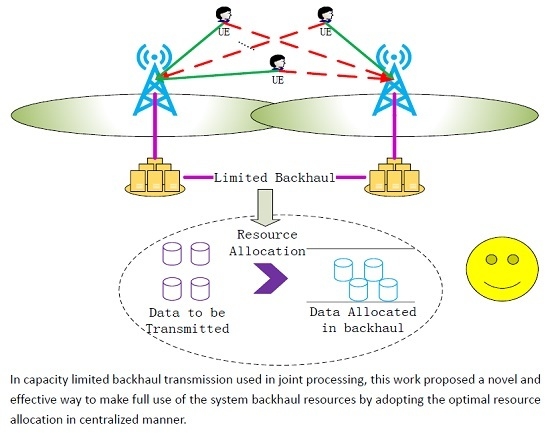A Novel Optimal Joint Resource Allocation Method in Cooperative Multicarrier Networks: Theory and Practice
Abstract
:1. Introduction
2. Main Contributions of This Work
- In this work, we divide the complex integer programming problem into three steps: The user pairing, resource allocation and compression of the system noise. This operation helps reduce the dimensionality and the complexity of the algorithm without losing system performance significantly. Related results of this work could be easily extended to the IoT scenario;
- We have proved the optimal result of the joint optimization problem using the three dimension optimization approach, and the theoretical results indicate that our proposed method could solve the multi-steps optimization problem at a satisfactory speed, so the system performance is improved significantly compared to reference methods;
- To evaluate the availability of our proposed method, we first propose a system level simulation to check the effectiveness of our method. Results indicate that our given method could be used in real systems and the performance meets the expectations studied in the theoretical analysis.
3. System Model Description
3.1. Preliminary
3.2. Signal and System Model
4. Joint Optimization Problem Formulation
4.1. The Achievble Rate
4.2. The Backhaul Overhead
4.3. Joint Optimization Problem
5. Our Proposed Novel Resource Allocation Scheme
5.1. Opitmize Compression Noise
5.2. Optimizing Backhaul Resource Allocation Vector
5.3. Optimizing User Pairing and Subcarrier Mapping :
5.4. Proposed Algorithm
| Algorithm 1: The Proposed Novel Resource Allocation Algorithm |
|
|
|
|
|
|
|
|
|
|
- The first step is the optimization of compression noise, where the complexity is
- The second step is resource allocation, where the complexity is:
- The last step is user pairing and subcarrier mapping, the complexity is:
6. Simulation and Analysis
6.1. Theoretical Analysis
6.2. System Level Simulation Results
7. Conclusions
- (1)
- We have studied the uplink optimal resource allocation with limited backhaul resources in a multicarrier coordinated network. A novel efficient algorithm based on an alternating optimization strategy has been put forward to solve the joint optimization problem of user pairing, subcarrier mapping and backhaul resource allocation. Simulation results show that the proposed algorithm can significantly improve system performance compared with blind schemes. They also illustrate that when CSI from neighbor cell is available, the channel aware backhaul allocation outperforms unaware schemes (random or equal strategy).
- (2)
- We discuss the system performance at a system level in advance. Through the system level simulation, we prove that our proposed method could work well with the currently working systems and the complexity is also acceptable. However, when CSI from a neighboring cell is unavailable, equal backhaul resource allocation is fairer, which will be studied in following work.
Acknowledgments
Author Contributions
Conflicts of Interest
References
- Karakayli, K.M.; Foschini, G.J.; Valenzuela, R.A. Network Coordination for Spectrally Efficient Communications in Cellular Systems. IEEE Wirel. Commun. 2006, 13, 56–61. [Google Scholar] [CrossRef]
- Jungnickel, V.; Schellmann, M.; Thiele, L.; Wirth, T. Interference Aware Scheduling in the Multiuser MIMO-OFDM Downlink. IEEE Commun. Mag. 2009, 47, 56–66. [Google Scholar] [CrossRef]
- Giese, J.; Awais, M.A. Performance Upper Bounds for Coordinated Beam Selection in LTE-Advanced. In Proceedings of the ITG/IEEE Wksp. Smart Antennas 10, Bremen, Germany, 23–24 February 2010.
- Müller, A.; Frank, P. Performance of the LTE Uplink with Intra-Site Joint Detection and Joint Link Adaptation. In Proceedings of the IEEE 2010 IEEE 71st Vehicular Technology Conference (VTC 2010–Spring), Taipei, Taiwan, 16–19 May 2010.
- Liao, W.-C.; Hong, M.; Luo, Z.-Q. Max-min network flow and resource allocation for backhaul constrained heterogeneous wireless networks. In Proceedings of the 2014 IEEE International Conference on Acoustics, Speech and Signal Processing (ICASSP), Florence, Italy, 4–9 May 2014; pp. 845–849.
- Tall, A.; Altman, Z.; Altman, E. Self-optimizing load balancing with backhaul-constrained radio access networks. IEEE Wirel. Commun. Lett. 2015, 4, 645–648. [Google Scholar] [CrossRef]
- Irmer, R.; Droste, H.; Marsch, P.; Grieger, M.; Fettweis, G.; Brueck, S.; Mayer, H.P.; Thiele, L.; Jungnickel, V. Coordinated multipoint: Concepts, performance, and field trial results. IEEE Commun. Mag. 2011, 49, 102–111. [Google Scholar] [CrossRef]
- Wyner, A.D.; Ziv, J. The rate-distortion function for source coding with side information at the decoder. IEEE Trans. Inform. Theory 1976, 22, 1–10. [Google Scholar] [CrossRef]
- Wyner, A.D. The rate-distortion function for source coding with side information at the decoder—II: General sources. Inform. Control 1978, 38, 60–80. [Google Scholar] [CrossRef]
- Sanderovich, A.; Shamai, S.; Steinberg, Y.; Kramer, G. Communication via decentralized processing. IEEE Trans. Inform. Theory 2008, 54, 3008–3023. [Google Scholar] [CrossRef]
- Forooshani, A.E.; Lotfi-Neyestanak, A.A.; Michelson, D.G. Optimization of Antenna Placement in Distributed MIMO Systems for Underground Mines. Wirel. Commun. IEEE Trans. 2014, 13, 4685–4692. [Google Scholar] [CrossRef]
- Cover, T.; Thomas, J. Elements of Information Theory, Wiley Series in Telecommunications, 1st ed.; Wiley: New York, NY, USA, 1991. [Google Scholar]
- Yang, Y.; Xiong, Z. Distributed Compression of Linear Functions: Partial Sum-Rate Tightness and Gap to Optimal Sum-Rate. In Proceedings of the 2011 IEEE Transactions on Information Theory, St. Petersburg, Russia, 31 July–5 August 2011; Volume 60, pp. 2157–8095.
- Rossi, T.; Pozzi, R.; Testa, M. A preliminary proposal to include capacity constraint in the multi-product EOQ model using hybrid systems and integer linear programming. In Proceedings of the 2015 International Conference on Industrial Engineering and Operations Management (IEOM), Dubai, United Arab Emirates, 3–5 March 2015; pp. 1–9.
- Ha, V.; Le, L.; Dao, N. Coordinated Multipoint (CoMP) Transmission Design for Cloud-RANs with Limited Fronthaul Capacity Constraints. IEEE Trans. Veh. Technol. 2015, PP. [Google Scholar] [CrossRef]
- Yang, S.; Jia, Y.; Min, Z.; Xiaohua, W. Channel capacity constraints of scalar Markov jump systems stabilization. In Proceedings of the 2014 33rd Chinese Control Conference (CCC), Nanjing, China, 28–30 July 2014; pp. 5700–5703.
- Li, X.; Zhai, Q.; Yuan, W.; Liu, J. Improved method of quantitative steady-state security assessment based on fast elimination of redundant transmission capacity constraints. In Proceedings of the 2015 27th Chinese Control and Decision Conference (CCDC), Qingdao, China, 23–25 May 2015; pp. 4242–4246.
- Ha, V.N.; Le, L.B.; Dao, N.-D. Cooperative transmission in cloud RAN considering fronthaul capacity and cloud processing constraints. In Proceedings of the 2014 IEEE Wireless Communications and Networking Conference (WCNC), Istanbul, Turkey, 6–9 April 2014; pp. 1862–1867.
- Abdelmoumen, M.; Jaidane, E.; Frikha, M.; Chahed, T. Performance of Delay Tolerant Mobile Networks under propagation and buffer capacity constraints. In Proceedings of the 2015 International Wireless Communications and Mobile Computing Conference (IWCMC), Dubrovnik, Italy, 24–28 August 2015; pp. 308–313.
- Setty, V.; Kreitz, G.; Urdaneta, G.; Vitenberg, R.; van Steen, M. Maximizing the number of satisfied subscribers in pub/sub systems under capacity constraints. In Proceedings of the 2014 IEEE International Conference on Computer Communications (INFOCOM), Toronto, ON, Canada, 27 April–2 May 2014; pp. 2580–2588.
- Tuninetti, D. On the capacity of the AWGN MIMO channel under per-antenna power constraints. In Proceedings of the 2014 IEEE International Conference on Communications (ICC), Sydney, NSW, Canada, 10–14 June 2014; pp. 2153–2157.
- Mirahsan, M.; Schoenen, R.; Yanikomeroglu, H.; Senarath, G.; Dung-Dao, N. User-in-the-loop for hethetnets with backhaul resource constraints. IEEE Wirel. Commun. 2015, 22, 50–57. [Google Scholar] [CrossRef]
- Zhou, Y.; Yu, W. Optimized Backhaul Compression for Uplink Cloud Radio Access Network. Sel. Areas Commun. IEEE J. 2014, 32, 1295–1307. [Google Scholar] [CrossRef]
- Seok-Hwan, P.; Simeone, O.; Sahin, O.; Shamai, S. Multivariate backhaul compression for the downlink of cloud radio access networks. In Proceedings of the 2014 IEEE International Symposium on Information Theory (ISIT), Honolulu, HI, USA, 29 June–4 July 2014; pp. 2699–2703.
- Seok-Hwan, P.; Simeone, O.; Sahin, O.; Shamai, S. Multihop backhaul compression for the uplink of cloud radio access networks. In Proceedings of the 2014 IEEE International Symposium on Information Theory (ISIT), Honolulu, HI, USA, 29 June–4 July 2014; pp. 2704–2708.
- Boustani, A.; Jadliwala, M.; Kwon, H.M.; Alamatsaz, N. Optimal resource allocation in Cognitive Smart Grid Networks. In Proceedings of the 2015 12th Annual IEEE Consumer Communications and Networking Conference (CCNC), Las Vegas, NV, USA, 9–12 January 2015; pp. 499–506.
- Marsch, P.; Fettweis, G. Uplink CoMP under a Constrained Backhaul and Imperfect Channel Knowledge. IEEE Trans. Wirel. Commun. 2011, 10, 1730–1742. [Google Scholar] [CrossRef]
- Rost, P. Robust and Efficient Multi-Cell Cooperation under Imperfect CSI and Limited Backhaul. IEEE Trans. Wirel. Commun. 2013, 12, 1910–1922. [Google Scholar] [CrossRef]
- Zhao, J.; Quek, T.Q.S.; Lei, Z. Semi-Distributed Clustering Method for CoMP with Limited Backhaul Data Transfer. In Proceedings of the 2013 IEEE Wireless Communications and Networking Conference (WCNC), Shanghai, China, 7–10 April 2013; pp. 3776–3781.
- Li, Y.; Wang, X.; Zhou, S.; Alshomrani, S. Uplink Coordinated Multipoint Reception with Limited Backhaul via Cooperative Group Decoding. IEEE Trans. Wirel. Commun. 2014, 13, 3017–3030. [Google Scholar] [CrossRef]
- Abboud, A.; Bastug, E.; Hamidouche, K.; Debbah, M. Distributed caching in 5G networks: An Alternating Direction Method of Multipliers approach. In Proceedings of the 2015 IEEE 16th International Workshop on Signal Processing Advances in Wireless Communications (SPAWC), Shanghai, China, 28 June–1 July 2015; pp. 171–175.
- Boyd, S.; Vandenberghe, L. Convex Optimization; Cambridge University Press: London, UK, 2004. [Google Scholar]
- Gani, A.Z. Interaction theory [new paradigm] for solving the assignment problem. In Proceedings of the 2014 International Conference of Advanced Informatics: Concept, Theory and Application (ICAICTA), Bandung, Indonesia, 20–21 August 2014; pp. 45–50.
- Chiang, H.-D.; Wang, T. A Novel TRUST-TECH Guided Branch-and-Bound Method for Nonlinear Integer Programming. Syst. Man Cybern. Syst. IEEE Trans. 2015, 45, 1361–1372. [Google Scholar] [CrossRef]
- Wei, W.; Xu, Q.; Wang, L.; Hei, X.H.; Shen, P.; Shi, W.; Shan, L. GI/Geom/1 queue based on communication model for mesh networks. Int. J. Commun. Syst. 2014, 27, 3013–3029. [Google Scholar] [CrossRef]
- Wei, W.; Yang, X.L.; Zhou, B. Combined energy minimization for image reconstruction from few views. Math. Probl. Eng. 2012, 2012. [Google Scholar] [CrossRef]
- Gao, Y.; Xue, P.; Li, Y.; Yu, H.; Wang, X.; Gao, S. Energy aware optimal resource allocation in backhaul constraint wireless networks: A two base stations scenario. Int. J. Distributed Sens. Netw. 2015, 2015. [Google Scholar] [CrossRef]
- Gao, Y.; Hong, A.; Zhou, Q.; Jian, C.; Zhou, B.; Zhou, W.; Li, Y. Optimal Backhaul resource Allocation with User Pairing in Uplink Coordinated Multicarrier Networks. In Proceedings of the 2015 International Conference on Identification, Information, and Knowledge in the Internet of Things (IIKI), Beijing, China, 22–23 October 2015; pp. 175–180.
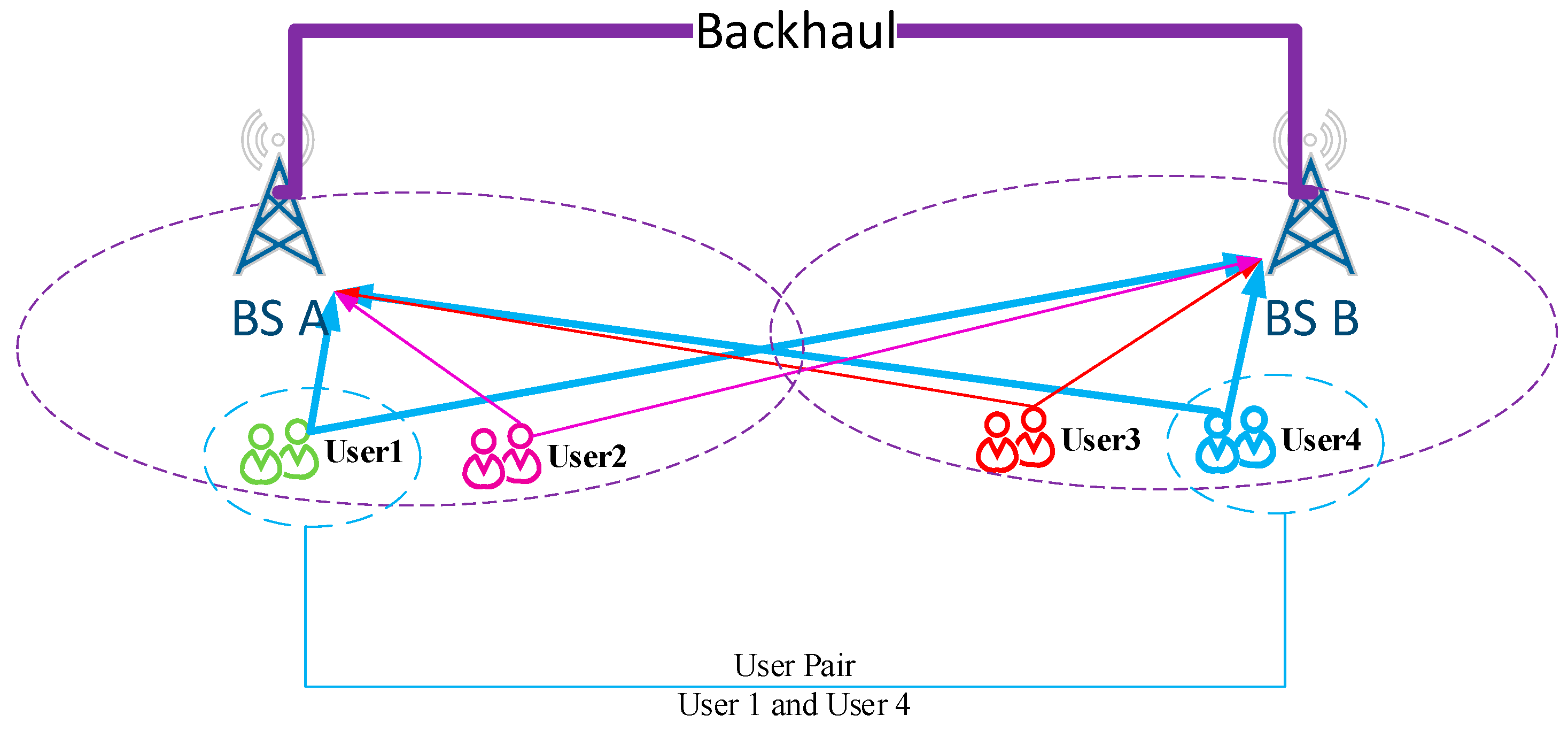
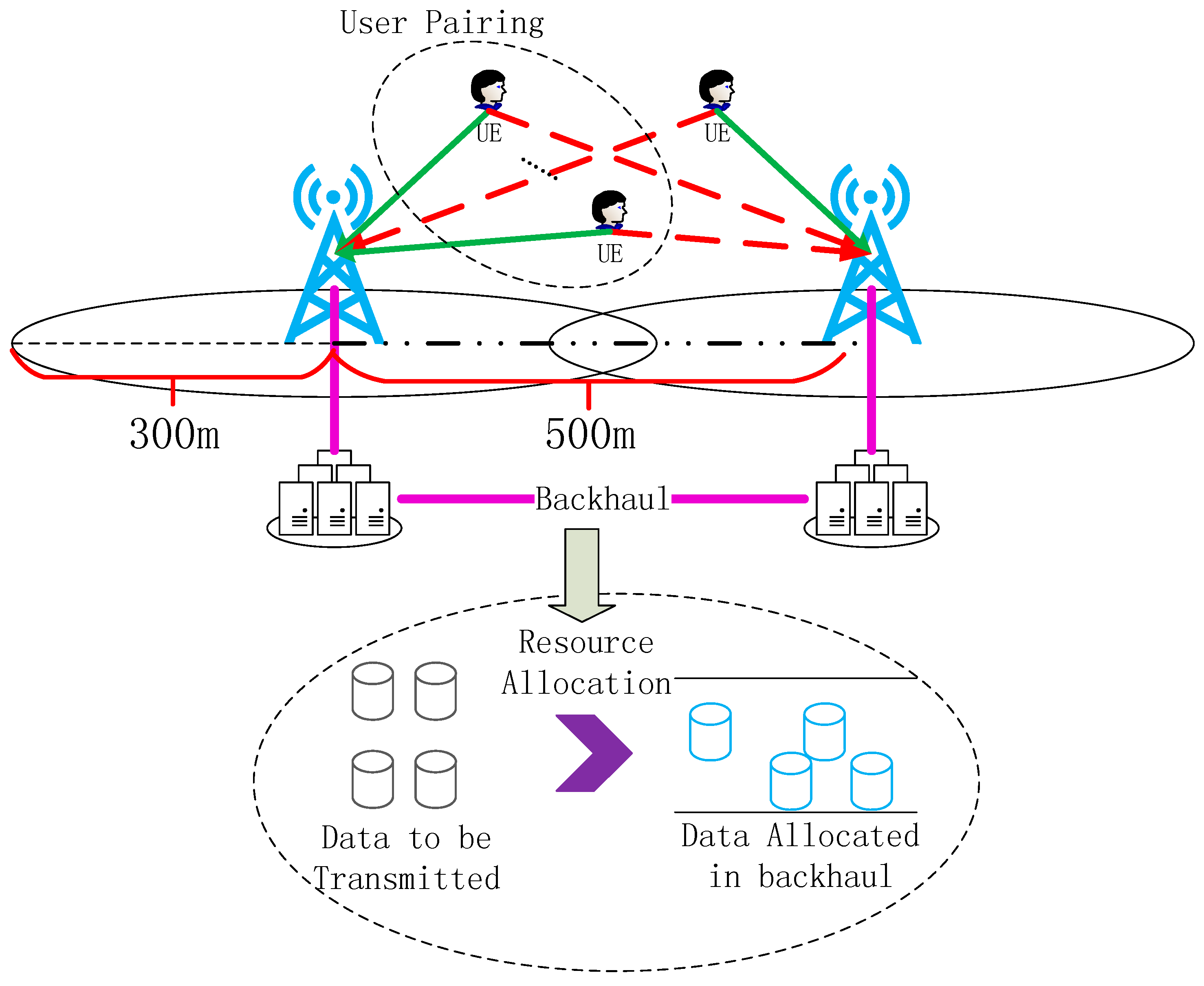
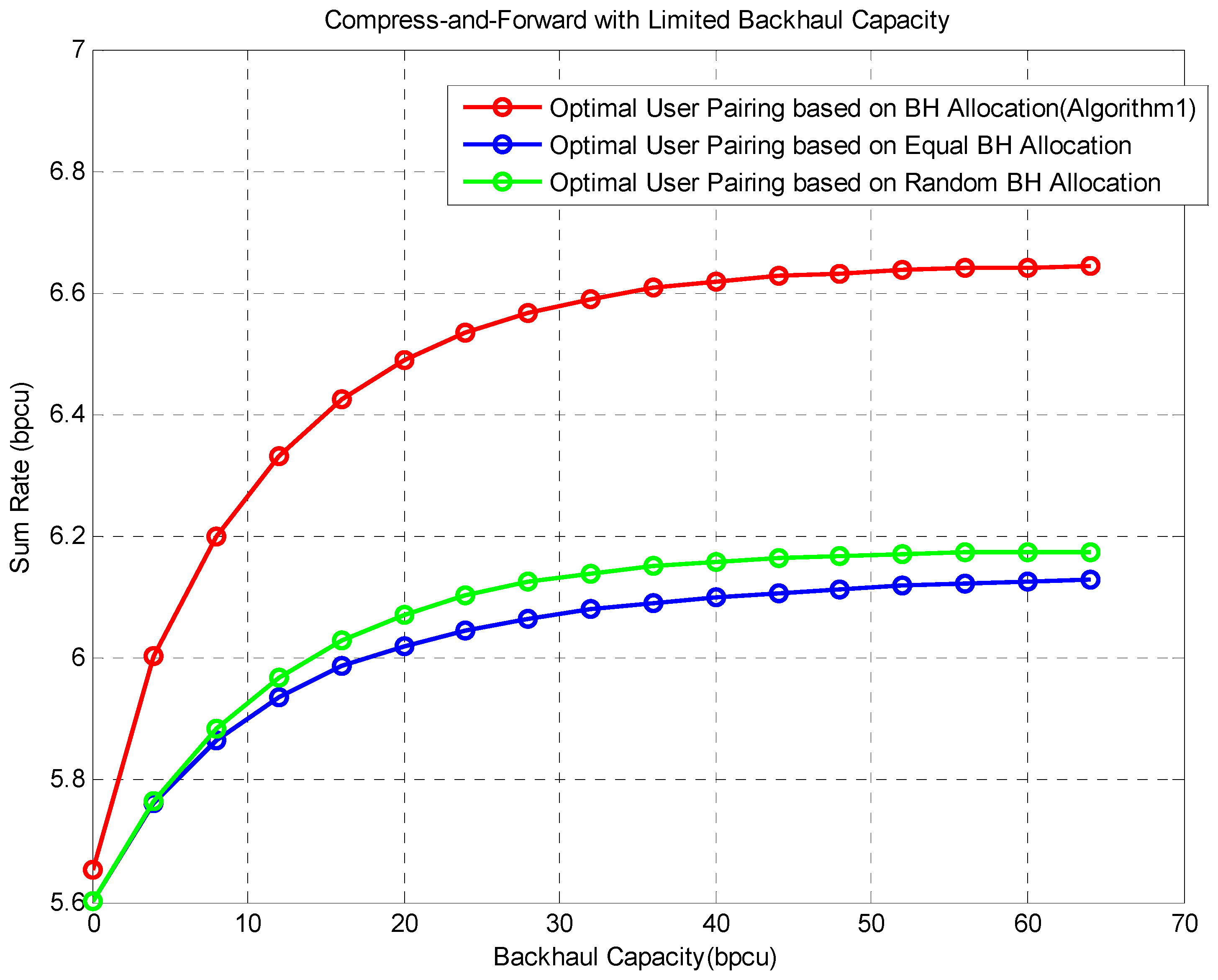
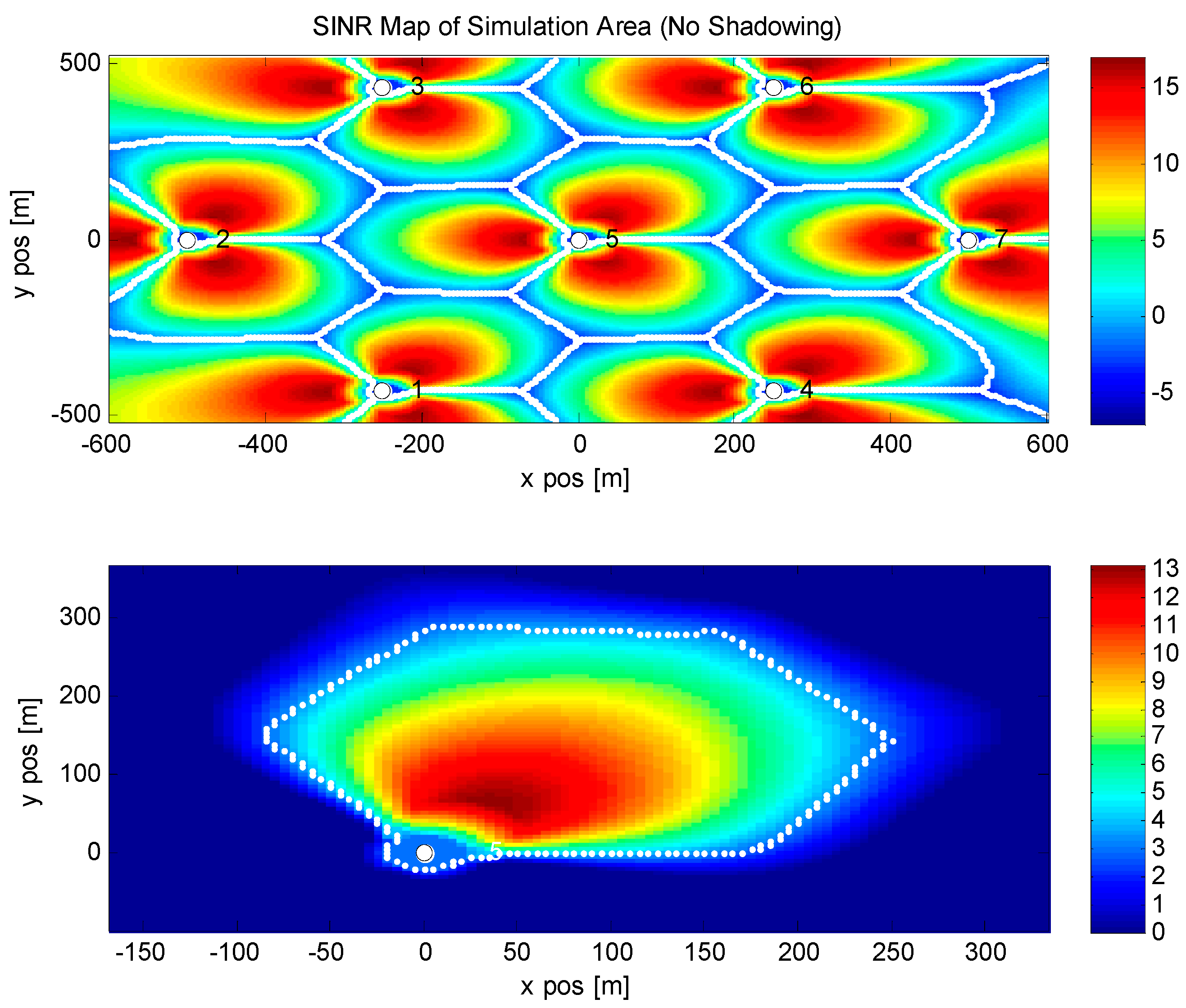
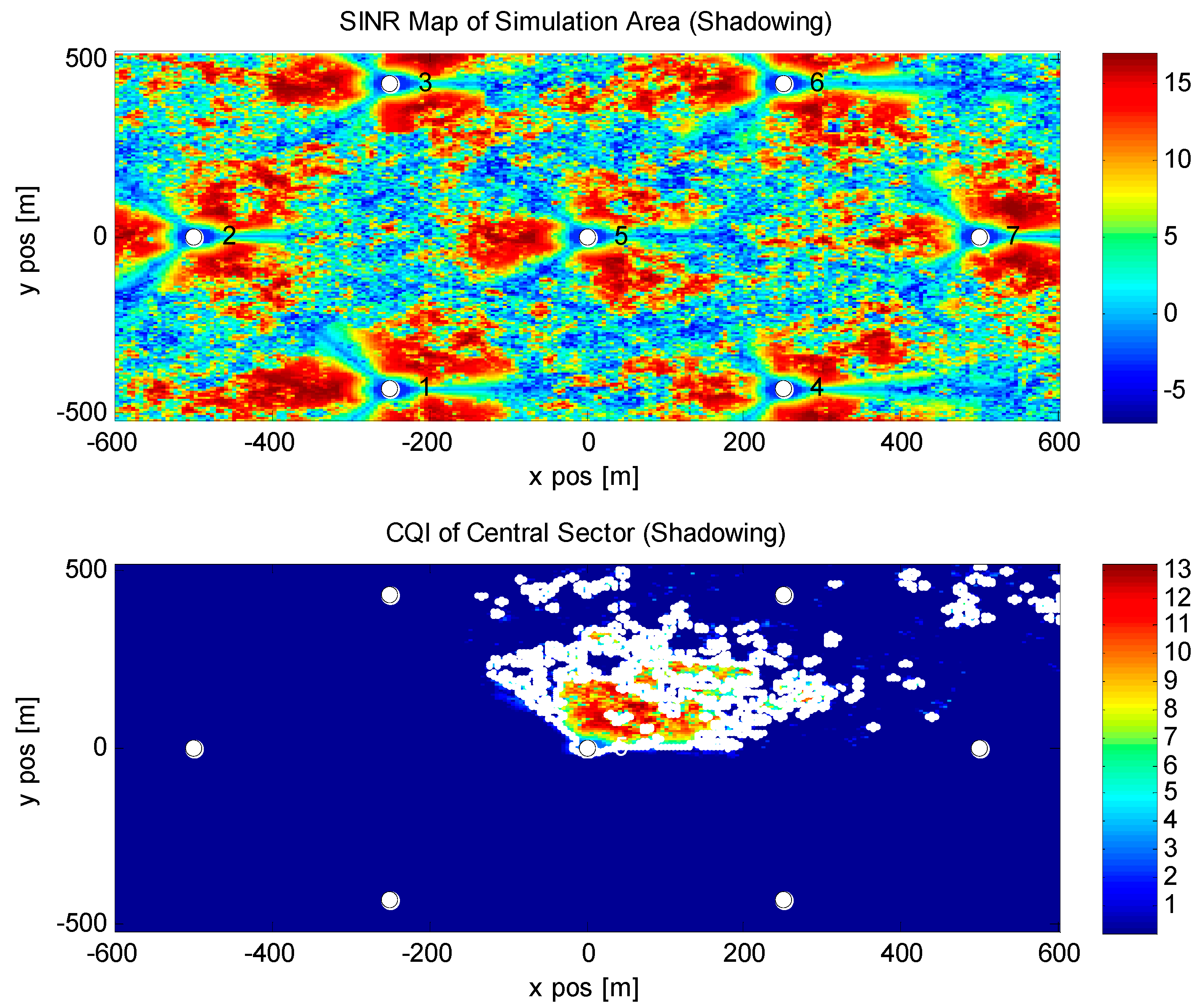
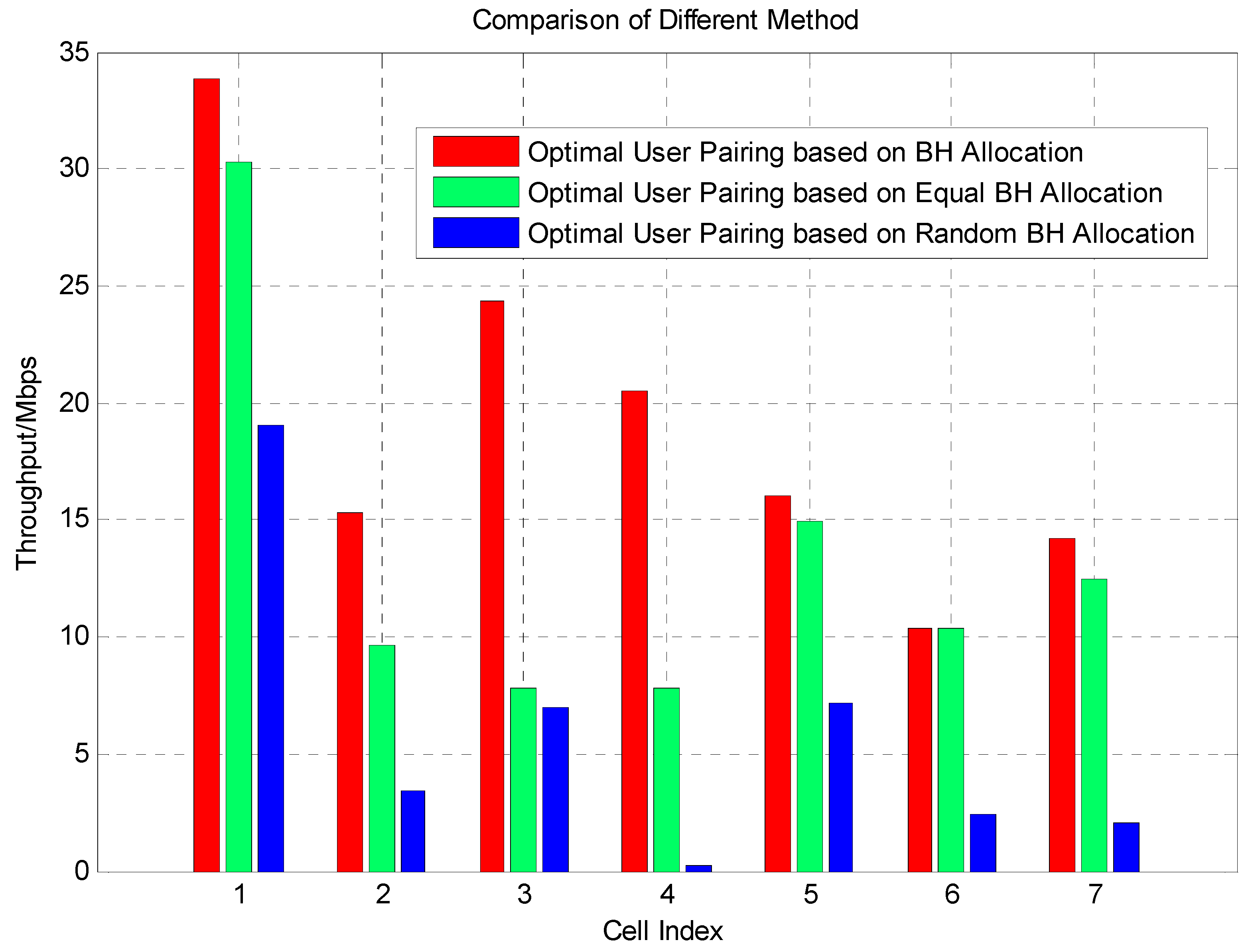
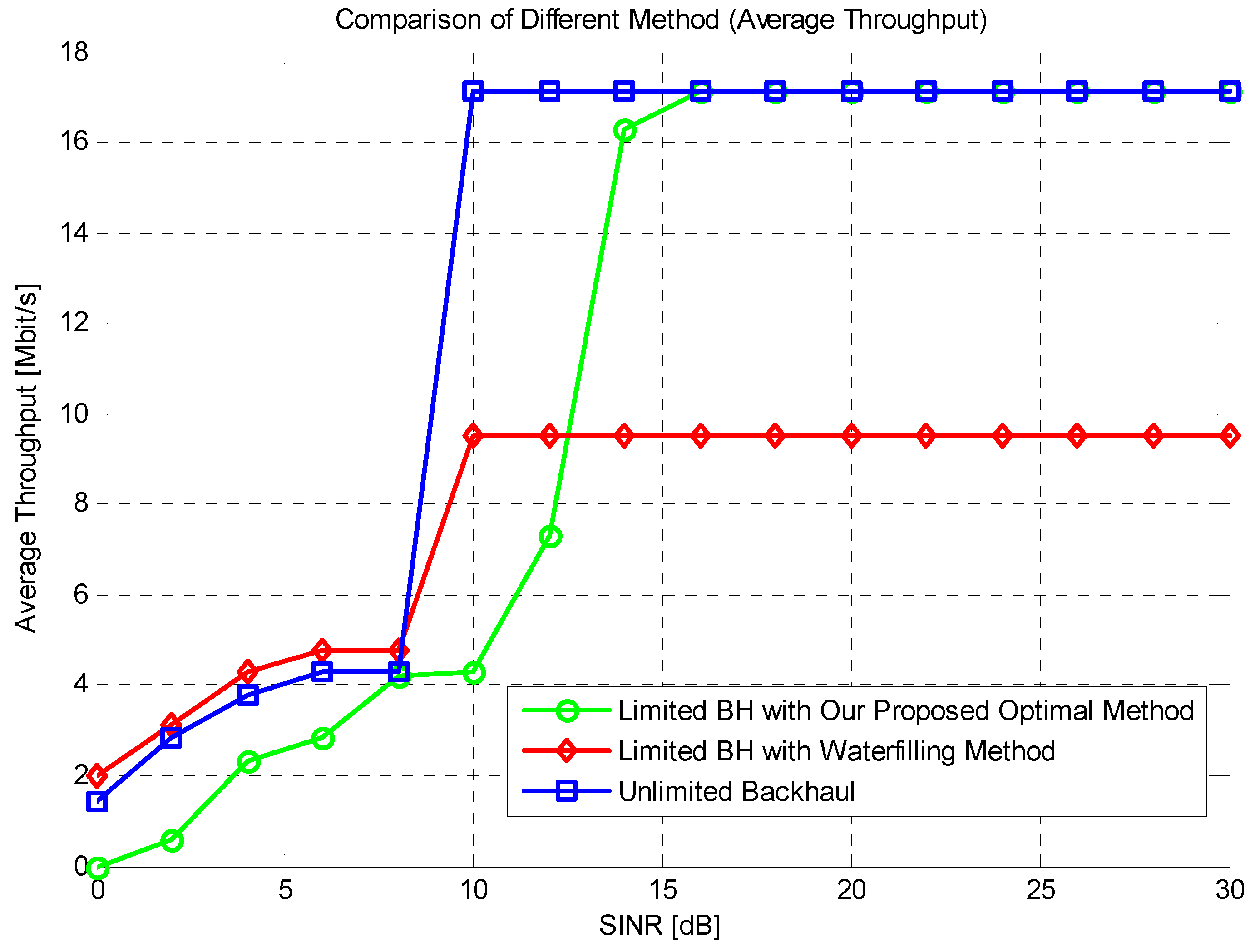
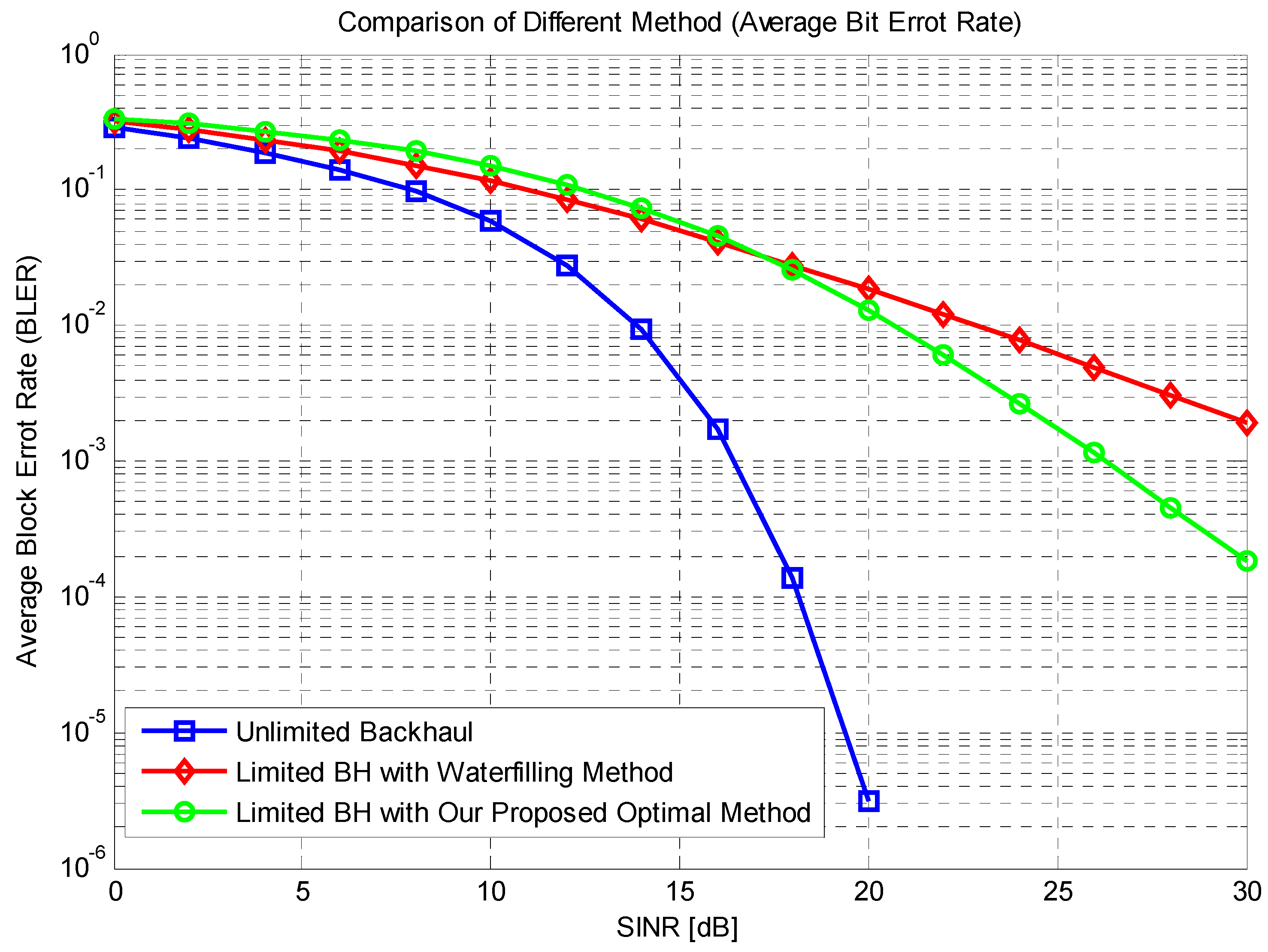
| Name | Parameter |
|---|---|
| Cell Layout | 7 Cell/21 Sector |
| Inter Cell Distance | 500 m |
| Transmission Bandwidth | 20 MHz |
| Antenna Configuration | 2 × 2 |
| BS TX Power | 6.3 Watt |
| Max Re-transmission time | 4 |
| Carrier Frequency | 2 GHz |
| HARQ Scheme | IR |
| Channel Model | SCME-Urban Micro |
| Pathloss | L = 128.1 + 37.6 × log10 (R) |
| Shadowing Std | 4 dB |
| Noise Power | −107 dBm |
| Service Type | Full Buffer |
| Simulation TTIs | 2000 |
| User Number | 210 total, 30 per Cell |
| UE Speed | 1 m/s |
| CQI measurement | Ideal |
| Adaptive Modulation and Coding Scheme (AMC) | QPSK (R ={1/8, 1/7, 1/6, 1/5, 1/4, 1/3, 2/5, 1/2, 3/5, 2/3, 3/4, 4/5}) 16QAM (R = {1/2, 3/5, 2/3, 3/4, 4/5}) |
| Target BLER | 0.1 |
| Cooperative Delay | 5~15 ms |
| CoMP Mode | Joint Processing |
| Backhaul Bandwidth | 20 MHz |
| Max CoMP Point | 3 |
© 2016 by the authors; licensee MDPI, Basel, Switzerland. This article is an open access article distributed under the terms and conditions of the Creative Commons by Attribution (CC-BY) license (http://creativecommons.org/licenses/by/4.0/).
Share and Cite
Gao, Y.; Zhou, W.; Ao, H.; Chu, J.; Zhou, Q.; Zhou, B.; Wang, K.; Li, Y.; Xue, P. A Novel Optimal Joint Resource Allocation Method in Cooperative Multicarrier Networks: Theory and Practice. Sensors 2016, 16, 522. https://doi.org/10.3390/s16040522
Gao Y, Zhou W, Ao H, Chu J, Zhou Q, Zhou B, Wang K, Li Y, Xue P. A Novel Optimal Joint Resource Allocation Method in Cooperative Multicarrier Networks: Theory and Practice. Sensors. 2016; 16(4):522. https://doi.org/10.3390/s16040522
Chicago/Turabian StyleGao, Yuan, Weigui Zhou, Hong Ao, Jian Chu, Quan Zhou, Bo Zhou, Kang Wang, Yi Li, and Peng Xue. 2016. "A Novel Optimal Joint Resource Allocation Method in Cooperative Multicarrier Networks: Theory and Practice" Sensors 16, no. 4: 522. https://doi.org/10.3390/s16040522





